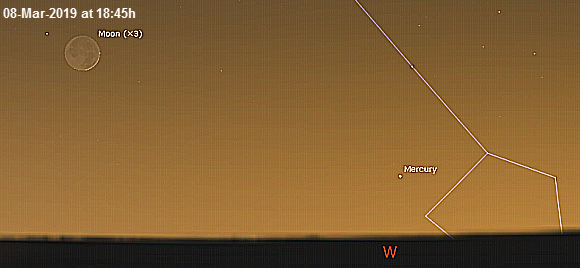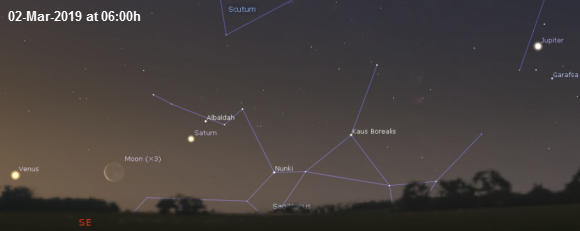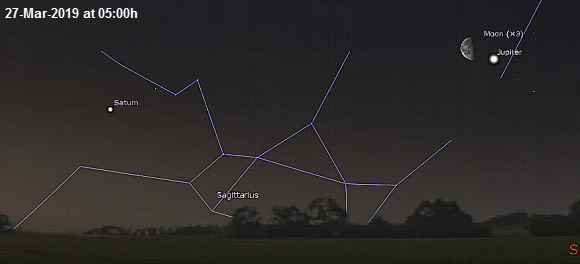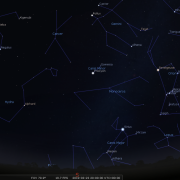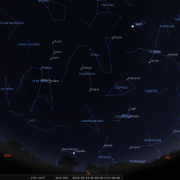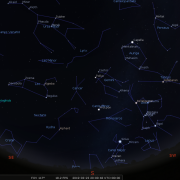In this month's Sky Notes:
- Planetary Skylights
- Meteors
- Spring Equinox
- February 2019 Sky Charts
Planetary Skylights
Evening Planets
 You can still glimpse Mercury in the evening twilight sky for the first week of March before it drops back toward the west horizon and is lost in solar glare. On March 2nd it reaches its greatest height above the horizon – around 9 degrees and at magnitude +0.9 should be pretty easy to spot with the naked eye. View between 18:15 to 18:45h (260 degree bearing) Use binoculars if you cannot spot it. A clear unobstructed aspect will be required. Mercury will rapidly diminish in brightness after the 5th, dropping back down. A very young crescent moon lies upper left on the 8th, but by the 10th Mercury is lost in twilight.
You can still glimpse Mercury in the evening twilight sky for the first week of March before it drops back toward the west horizon and is lost in solar glare. On March 2nd it reaches its greatest height above the horizon – around 9 degrees and at magnitude +0.9 should be pretty easy to spot with the naked eye. View between 18:15 to 18:45h (260 degree bearing) Use binoculars if you cannot spot it. A clear unobstructed aspect will be required. Mercury will rapidly diminish in brightness after the 5th, dropping back down. A very young crescent moon lies upper left on the 8th, but by the 10th Mercury is lost in twilight.
 Mars spends the first half of March moving up through Aries, crossing into Taurus later in the month and heading toward the Pleiades star cluster (M45) which it passes as March turns to April, lying 3 degrees to the east of the cluster. The Martian disk is now very small and most amateur scopes will struggle to reveal anything but the gibbous phase. The moon lies lower left on the 11th.
Mars spends the first half of March moving up through Aries, crossing into Taurus later in the month and heading toward the Pleiades star cluster (M45) which it passes as March turns to April, lying 3 degrees to the east of the cluster. The Martian disk is now very small and most amateur scopes will struggle to reveal anything but the gibbous phase. The moon lies lower left on the 11th.
Dawn Planets
And now for the Dawn Sky.
 In the dawn sky Venus hugs the SE horizon, becoming increasingly difficult to spot as we head into the latter third of the month. Only its brilliance saves it from being swamped by dawn twilight. The crescent moon sits between it and Saturn on the 2nd around 06:15h.
In the dawn sky Venus hugs the SE horizon, becoming increasingly difficult to spot as we head into the latter third of the month. Only its brilliance saves it from being swamped by dawn twilight. The crescent moon sits between it and Saturn on the 2nd around 06:15h.
 Saturn starts the month almost due SE, a few degrees above the horizon viewing around 06:00h. By the end of March it has moved a little further round to the south and gained a few degrees in altitude (viewing now at 06:00h). Because Saturn resides in Sagittarius all year, it’s always going to be pretty low to the horizon, and observations are going to be somewhat compromised due to our atmosphere. Nevertheless if you have a telescope your patience at the eyepiece will ultimately be rewarded, a glimpse of the ring system is not a site forgotten in a hurry. A slim waning crescent moon lies off to the right on the first morning of March and just below Saturn on 29th.
Saturn starts the month almost due SE, a few degrees above the horizon viewing around 06:00h. By the end of March it has moved a little further round to the south and gained a few degrees in altitude (viewing now at 06:00h). Because Saturn resides in Sagittarius all year, it’s always going to be pretty low to the horizon, and observations are going to be somewhat compromised due to our atmosphere. Nevertheless if you have a telescope your patience at the eyepiece will ultimately be rewarded, a glimpse of the ring system is not a site forgotten in a hurry. A slim waning crescent moon lies off to the right on the first morning of March and just below Saturn on 29th.
 Jupiter starts to dominate the dawn sky residing to the south as skies brighten. View around 06:00h at the start of the month and before 05:00h toward the end. By then Jupiter’s magnitude has increased to -2.3, with a disc size of almost 40 arc seconds, big enough for plenty of detail in the atmosphere to be observed. By the end of the month Jupiter is above the southeast horizon by 02:00h. If you view on the 27th, Jupiter is just over a degree from the rising waning crescent moon, a great photographic opportunity.
Jupiter starts to dominate the dawn sky residing to the south as skies brighten. View around 06:00h at the start of the month and before 05:00h toward the end. By then Jupiter’s magnitude has increased to -2.3, with a disc size of almost 40 arc seconds, big enough for plenty of detail in the atmosphere to be observed. By the end of the month Jupiter is above the southeast horizon by 02:00h. If you view on the 27th, Jupiter is just over a degree from the rising waning crescent moon, a great photographic opportunity.
Dates of interest for Galilean moon events are
- 3rd: Io shadow transit 06:00h
- 11th: Europa shadow transit 04:00h: and both Io and Ganymede start transits around 05:04h.
- 18th: Ganymede shadow starts transit 04:00h: and on the
- 19th: Io starts shadow transit 03:40h and Io itself from 05:00h.
The great red spot transits the disk on the following dates. 3/4th; 8/9th; 13-16th; 25/26th 03:00-05:00h.
Meteors

No major showers this month. However at the very end of March you may spot a few Virginids, which are slow moving and have long paths. As usual early morning hours are best to spot any meteors.
Spring Equinox
The date of the Vernal Equinox and of astronomical spring in the northern hemisphere (the official start of spring) falls on March 20th this year. This is when the Sun's path - the ecliptic, first crosses the celestial equator on its apparent journey northwards into the sky. The orientation of the Earth at the spring or autumnal equinox is such that neither of Earth’s poles are inclined toward the Sun and all locations experience equal hours of daylight and darkness - hence the term equinox.
The Vernal Equinox is also known as the 'First point of Aries', as the Sun used to stand before the constellation of the Ram when it first crossed the celestial equator. Although still called the 'first point of Aries', today its location now resides in Pisces, a consequence of the effect known as precession - the Earth's slow wobble Over thousands of years our ancestors noted that certain star patterns rose just before the Sun at specific times and were considered significant for this very reason. Subsequently they were able to build a picture of the apparent path of the Sun against these constellations.
The narrow path upon which occasionally the Sun and Moon would meet giving rise to an eclipse, became known as the Ecliptic. The broader belt along which the 'wandering stars' or planets travelled was known as the Zodiac, so called because all 12 constellations located on it were associated with living creatures.
Zodiac literally means 'Band of Animals'. Libra used to be considered being part of Scopius, the claws to be precise. Ophiuchus, the serpent bearer immediately following Scorpius was instead regarded as a zodiac group. Ever since the stars of Libra were elevated in status, Ophiuchus, being surplus to requirements, was ditched, much to the relief of astrologers. If you find it difficult to remember the order of the zodiac constellations, then the following rhyme may be of use.
The Ram, the Bull, the Heavenly twins and next the Crab the Lion shines, the Virgin, and the Scales. Scorpion, Archer and Sea goat, the man who pours the water out and Fish with glittering tails
March 2019 Sky Charts
|
Looking North
Latish March - 20:00h |
Looking South |
|
Looking East
Latish March - 20:00h |
Looking West
Latish March - 20:00h |
|
Northern Aspect
Latish March - 20:00h |
Southern Aspect
Latish March - 20:00h |
| Looking North (Early) Mid-March - 05:00h |
Looking South (Early) Mid-March - 05:00h |
Additional Image Credits:
- Planets and Comets where not otherwise mentioned: NASA
- Sky Charts: Stellarium Software
- Log in to post comments


